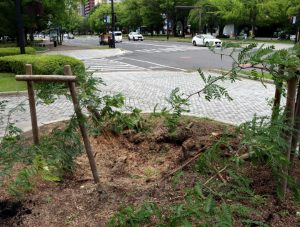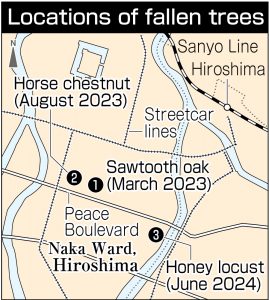Three trees fall over on Peace Boulevard in just over the course of one year—one even supported by props
Jun. 25, 2024
by Yu Kawakami, Staff Writer
Trees have fallen down one after another on Peace Boulevard in central Hiroshima. In little over the course of a year, three trees have toppled. One tree that fell on June 23 was about 70 years old and had previously been propped up. The tree had been under observation ever since all trees were inspected last September. The city is planning to conduct another round of inspections this fall. Many people come and go along this street, and the city government must step up security measures promptly.
This particular tree that fell was a honey locust in the greenbelt on the south side of Peace Boulevard in Tsurumi-cho, Naka Ward. It was about 10 meters tall with a trunk circumference of 2.3 meters. No one was injured. The city removed the tree after cutting its trunk into small pieces on June 24. It is believed the trunk had broken at the base due to heavy rain; the city will soon work with an arborist to obtain more detailed information about the cause.
A 16-meter-tall sawtooth oak on Peace Boulevard fell over in March of last year, and the trunk of a seven-meter-tall horse chestnut broke in August. Last September, arborists inspected approximately 1,800 trees and determined the honey locust was “gravely damaged.” However, the city decided not to cut down the tree, as it had been supported by props since 2020.
According to the city, the tree grew from seed given to the city in a wish for peace by Eva Peron, wife of a president of Argentina, whose life was depicted in the musical “Evita.” The seed was received in 1953, a year after her death. Many other trees have been planted along the street, many of which were donated from Japan and other countries after the “Tree-planting Campaign” carried out in 1957 and 1958, in which the financially-strapped city government called on local governments in Hiroshima Prefecture to donate trees.
Naka Ward’s maintenance division plans to begin inspecting all trees again this September, or later in the year. If they determine what caused a tree to fall, the inspection items will be reviewed. The division will give priority to inspecting tall trees that are under observation, and will work to prevent a recurrence for the safety of citizens passing along Peace Boulevard.
(Originally published on June 25, 2024)
Trees have fallen down one after another on Peace Boulevard in central Hiroshima. In little over the course of a year, three trees have toppled. One tree that fell on June 23 was about 70 years old and had previously been propped up. The tree had been under observation ever since all trees were inspected last September. The city is planning to conduct another round of inspections this fall. Many people come and go along this street, and the city government must step up security measures promptly.
This particular tree that fell was a honey locust in the greenbelt on the south side of Peace Boulevard in Tsurumi-cho, Naka Ward. It was about 10 meters tall with a trunk circumference of 2.3 meters. No one was injured. The city removed the tree after cutting its trunk into small pieces on June 24. It is believed the trunk had broken at the base due to heavy rain; the city will soon work with an arborist to obtain more detailed information about the cause.
A 16-meter-tall sawtooth oak on Peace Boulevard fell over in March of last year, and the trunk of a seven-meter-tall horse chestnut broke in August. Last September, arborists inspected approximately 1,800 trees and determined the honey locust was “gravely damaged.” However, the city decided not to cut down the tree, as it had been supported by props since 2020.
According to the city, the tree grew from seed given to the city in a wish for peace by Eva Peron, wife of a president of Argentina, whose life was depicted in the musical “Evita.” The seed was received in 1953, a year after her death. Many other trees have been planted along the street, many of which were donated from Japan and other countries after the “Tree-planting Campaign” carried out in 1957 and 1958, in which the financially-strapped city government called on local governments in Hiroshima Prefecture to donate trees.
Naka Ward’s maintenance division plans to begin inspecting all trees again this September, or later in the year. If they determine what caused a tree to fall, the inspection items will be reviewed. The division will give priority to inspecting tall trees that are under observation, and will work to prevent a recurrence for the safety of citizens passing along Peace Boulevard.
(Originally published on June 25, 2024)









